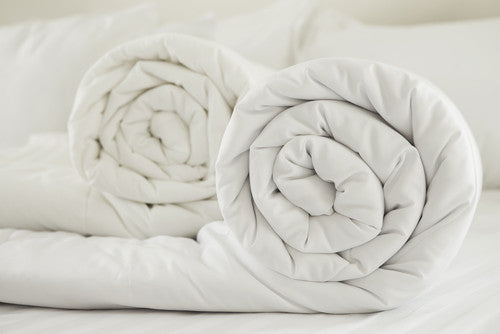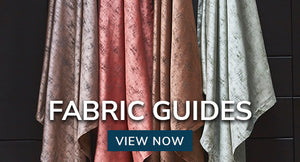Considerations when buying bedding: fibre, weight, thread count and finish
Consumers think about a number of things when interested in buying bedding. Style absolutely plays a huge part in the selection. Nice-looking bedding is, well, nice looking. Adding artistic and aesthetically wonderful bedding to a room definitely enhances the look. Looks should not, however, be the only criteria to weigh when buying bedding. After all, the bedding has to be comfortable to sleep on.
So, the fibre composition of the bedding should never be overlooked.

Bedding fibre and material
Fibre Choices
To meet the needs and budgets of many customers, numerous different types of fibre bedding are sold. Those interested in very high-end fibre could always buy silk bedding. A person seeking something far less expensive may opt for traditional polyester or polyester/cotton. Of course, the lower cost fibres may not deliver the same benefits as the higher cost ones, however, they are usually far more user friendly, easier to care for and launder.
Functional Cotton
Basic cotton bedding will keep people warm under the sheets during cold winter months. Cotton bedding has been serving this purpose for centuries. The low thread count and finish of cotton bedding does not exactly contribute to very high comfort. Still, cotton does the job intended of it and is going to remain forever popular.
100% cotton may be preferable to many, but a cotton-polyester blend is also a good choice. While not the same quality level as all-cotton, cotton-polyester comes close – and the price is a lot lower.
Practical Polyester/Cotton
A mixture of man-made and natural materials have made laundering bedding far easier. This combination of materials also results in lower prices with the added advantage of being available in any colour or pattern you like. Polyester/cotton is affordable, giving you the flexibility to change your bedding more frequently to launder and to give your bedrooms a new look without the expense of completely redecorating.
More Exquisite Materials
Silk and faux silk are luxurious, yet the former comes at a price. Soft and literally silky smooth against your skin, silk sheets are deemed to be sensuous and seductive, so maybe keep them for special occasions! Faux silk is, as the name implies, a man-made version of silk. It also has a sleek, glossy texture but without the price tag attached.
Speciality Bedding
The look of hemp or other speciality bedding may also provide added decorative value. Functional, but bland bedding has its value, but the value is somewhat limited and not the choice of most people.
Bedding weight
Weight
Being swaddled in heavy bedding isn't to most people's liking. In the past, before the introduction of duvets, bedding could be extremely heavy. However, when you consider that homes didn't have central heating bedrooms could be very cold during the winter months, so snuggling under a mountain of blankets and eiderdowns was the only way to keep warm!
Today central heating and the duvet has revolutionised the way we make our beds. Available in a range of weights, tog ratings, we can have warmth without weight when we use a duvet.
Lightweight duvets are ideal for most during the summer months. These have a typical tog rating of 3.5 or 4. During spring and autumn 8 or 10 tog rated duvets suffice, while in winter 14.5 is the norm. For chilly morsels combinations of a winter and spring duvets, usually press studded together, provide ample warmth.
Sheets also have a weight, with finer cotton sheets weighing far less than flannel. Again, the heavier flannel sheets are good for winter use, however, they do take longer to dry both outdoors and in a tumble drier.
The lightest weight sheets are those made with fine silk. Luxurious, it would be fair to say that not many of us sleep on pure silk sheets, although there is the option of faux silk which provide the same luxury softness next to the skin without the expense of the genuine article. Faux silk are also much easy to launder!
Blankets come in a variety of weights too. Man-made fibres such as polyester are lightweight, yet keep you beautifully warm. Pure wool blankets provide ultimate warmth but they can be extremely weighty.
Quilted bedspreads look amazing but they can be pretty heavy to sleep under. As such they are most often used only in winter or as a protector for when the bed is made during the daytime. Most people remove a quilted bedspread before getting into bed.
Thread Count
What is a bedding thread count?
The thread count of bedding is something that is used to distinguish the quality of it – higher thread counts are generally higher quality. The more threads per square inch of fabric then the softer that fabric will feel. You can read more on thread count and why it is so important in our handy guide.
A thread count that reveals the weaving of exquisite hemp fibre is going to preserve a much lighter weight. This adds to the comfort level of the bedding immensely. The lightweight style is almost unnoticeable as it rests on someone sleeping. Yet the fibres are reliable enough to maintain warmth.
All in all thread count does provide you with an insight as to the softness of sheets, but as mentioned above, don't get bogged down with it. Look for good quality at an affordable price and you won't go far wrong!

Finish
Thread count and fibre composition should never be overlooked, but do not ignore the finish of the bedding – it really is important! The finish on bedding does help preserve the life of the material since the finish is what protects the fibre.
The weave of the thread is important. A percale weave is the most prominent. It is a balanced weave that provides a crisp, cool feel which is also durable.
Sateen weave is another one to look out for. It has a softer feel than percale and is a little warmer too.
Types of bedding
Egyptian cotton sheets are revered as the best. It is soft, durable and can be bought at a very reasonable price. However, sheets made from Egyptian cotton will require ironing, something many busy households simply don't have time for! Step in polyester-cotton bedding to save time, effort and money. This practical choice is easy to launder and maintain and is available in an extensive range of colours, patterns and designs.
The finish on polyester-cotton is generally soft and yet it is also durable, providing longevity and value for money.
Don't forget that bedding with embellishments such as lace or silk trimmings, sequins or lightweight beads may require more maintenance, however, these also offer a touch of class and style to a bedroom, so they shouldn't be overlooked.
Bedding manufacturers
Different bedding manufacturers will sell products with varying degrees of chemical treatments. Ultimately, the finish treatment helps keep the bedding looking as good as new for a long time after the bedding was purchased. A series of washings can have unwanted effects – i.e. shrinking and fading – over time. A proper finish cuts down on how bad these effects are.
Does this seem like there is a lot to consider when buying bedding? Yes, a bit of thought is required to purchase the right bedding with the right look, feel, texture, and function. Consumers are going to end up thrilled they did ponder many things when the end result of their efforts lead to the best buying decision.
There are plenty of bedding choices available depending on your budget and what you want it to achieve. As you spend approximately one third of your life in bed make sure you choose bedding that meets your needs. Soft, comfortable and easy to maintain, along with style, design and colour should be the main reasons for selecting your bedding.


























































